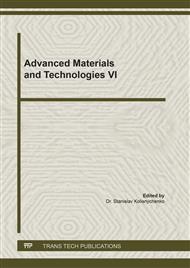[1]
L.R.G. Treloar, The Elasticity and Related Properties of Rubbers, Rubber Chem. Technol. 47 (1974) 625–696.
DOI: 10.5254/1.3540456
Google Scholar
[2]
A. Ciesielski, An Introduction to Rubber Technology, Rapra Technology Limited, Shropshire, 1999. http://en.tafp.org.tw/ebooks/download/asin=1859571506&type=stream (accessed September 23, 2017).
Google Scholar
[3]
Treloar, L.R.G. (1958) Physics of Rubber Elasticity. 2nd Edition, Oxford University Press, London. - References - Scientific Research Publishing, (n.d.). https://www.scirp.org/(S(i43dyn45teexjx455qlt3d2q))/reference/ReferencesPapers.aspx?ReferenceID=2054067 (accessed October 19, 2019).
Google Scholar
[4]
M. Bijarimi, H. Zulkafli, M.D.H. Beg, Mechanical properties of industrial tyre rubber compounds, J. Appl. Sci. 10 (2010) 1345–1348.
DOI: 10.3923/jas.2010.1345.1348
Google Scholar
[5]
N. Hayeemasae, A. Masa, Relationship between stress relaxation behavior and thermal stability of natural rubber vulcanizates, Polimeros. 30 (2020).
DOI: 10.1590/0104-1428.03120
Google Scholar
[6]
H.G.I.M. Wijesinghe, U.N. Ratnayake, A. Alakolanga, N.S. Withanage, Raw rubber and viscoelastic properties of organoclay filled latex crepe rubber, J. Rubber Res. Inst. Sri Lanka. 95 (2015) 39.
DOI: 10.4038/jrrisl.v95i0.1835
Google Scholar
[7]
G. (Gert) Heinrich, G.C. Basak, Advanced rubber composites, Springer, (2011).
Google Scholar
[8]
J. Sapkota, Influence of Clay Modification on Curing Kinetics of Natural Rubber Nanocomposites, Tampere University of Technology, 2011. https://dspace.cc.tut.fi/dpub/handle/123456789/20785?show=full (accessed September 24, 2017).
Google Scholar
[9]
M. Arroyo, M.A. López-Manchado, B. Herrero, Organo-montmorillonite as substitute of carbon black in natural rubber compounds, Polymer (Guildf). 44 (2003) 2447–2453.
DOI: 10.1016/s0032-3861(03)00090-9
Google Scholar
[10]
M.C.W. Somaratne, Reinforcement of Natural Rubber Latex Films with Fine Particle Fillers, University of Moratuwa, (2013).
Google Scholar
[11]
N.T. Quang, D.V. Hung, B. Chuong, H. Nam, N.T. Yen, Study on the effect of modified and unmodified silica on the properties of natural rubber vulcanizates, Vietnam J. Chem. 57 (2019) 357–362.
DOI: 10.1002/vjch.201900040
Google Scholar
[12]
C.C. Ihueze, C.O. Mgbemena, Static analysis of a P195 / 55 R16 85H radial tire developed from natural rubber / tea seed oil ( Camellia sinensis ) modified kaolin vulcanizates, Am. J. Mech. Eng. Autom. 1 (2014) 31–37.
DOI: 10.9734/jsrr/2014/11587
Google Scholar
[13]
C.O. Mgbemena, C.C. Ihueze, A.R.R. Menon, Performance characteristics and analysis of tailored Natural Rubber/Organo-kaolin Composites, Int. J. Plast. Technol. 20 (2016) 11–27.
DOI: 10.1007/s12588-016-9142-7
Google Scholar
[14]
C.O. Mgbemena, T.E. Boye, I. Emovon, Static Analysis of a Tire Sidewall Developed From Tailored Organomodified Kaolin/Natural Rubber Vulcanizates, J. Adv. Eng. Comput. 1 (2017) 106.
DOI: 10.25073/jaec.201712.83
Google Scholar
[15]
C. Ihueze, C. Mgbemena, Modeling Hyperelastic Behavior of Natural Rubber/Organomodified Kaolin Composites Oleochemically Derived from Tea Seed Oils (Camellia sinensis) for Automobile Tire Side Walls Application, J. Sci. Res. Reports. 3 (2014) 2528–2542.
DOI: 10.9734/jsrr/2014/11587
Google Scholar
[16]
M. Wu, N. Vennemann, M. Heinz, Investigation of Un-Vulcanized Natural Rubber by Means of Temperature Scanning Stress Relaxation Measurements, (n.d.).
DOI: 10.4028/www.scientific.net/amr.718-720.117
Google Scholar
[17]
S. Trangadisaikul, Oligopsony in the Tire Industry: A Study of its Impacts on the Natural Rubber Industry in Thailand, Charles Sturt University, 2009. http://web.mit.edu/course/21/21.guide/toc.htm (accessed July 8, 2017).
Google Scholar
[18]
J.W. Yu, J. Jung, Y.-M. Choi, J.H. Choi, J. Yu, J.K. Lee, N.-H. You, M. Goh, Enhancement of the crosslink density, glass transition temperature, and strength of epoxy resin by using functionalized graphene oxide co-curing agents, Polym. Chem. 7 (2016) 36–43.
DOI: 10.1039/c5py01483b
Google Scholar
[19]
C.O. Mgbemena, C.C. Ihueze, A.R.R. Menon, Performance characteristics and analysis of tailored Natural Rubber/Organo-kaolin Composites, Int. J. Plast. Technol. (2016).
DOI: 10.1007/s12588-016-9142-7
Google Scholar
[20]
C.O. Mgbemena, N.O. Ibekwe, R. Sukumar, A.R.R. Menon, Characterization of kaolin intercalates of oleochemicals derived from rubber seed (Hevea brasiliensis) and tea seed (Camelia sinensis) oils, J. King Saud Univ. - Sci. 25 (2013) 149–155.
DOI: 10.1016/j.jksus.2012.11.004
Google Scholar
[21]
C.O. Mgbemena, C.E. Mgbemena, F.I. Ashiedu, A.R.R. Menon, Static analysis of tyre model developed from Natural Rubber vulcanizates, in: Lect. Notes Eng. Comput. Sci., (2016).
Google Scholar
[22]
R. Ramakrishnan, J.D. Sudha, V.L. Reena, Nanostructured polyaniline-polytitanate-clay composite for photocatalytic applications: preparation and properties, RSC Adv. 2 (2012) 6228.
DOI: 10.1039/c2ra20613g
Google Scholar
[23]
N. Hasegawa, M. Kawasumi, M. Kato, A. Ukudi, A. Okada, Preparation and mechanical properties of polypropylene-clay hybrids using a maleic-anhydride grafted polypropylene oligomer, J. Appl. Polym. Sci. 67 (1998) 87–92.
DOI: 10.1002/(sici)1097-4628(19980103)67:1<87::aid-app10>3.0.co;2-2
Google Scholar
[24]
P.L. Teh, Z.A.M. Ishak, A.S. Hashim, J. Karger-Kocsis, U.S. Ishiaku, Effects of epoxidized natural rubber as a compatibilizer in melt comp ounded natur al rubber-organoclay nanocomposites, Eur. Polym. J. 40 (2004) 2513–2521.
DOI: 10.1016/j.eurpolymj.2004.06.025
Google Scholar
[25]
J.M. Lagaron, L. Cabedo, D. Cava, J.L. Feijoo, R. Gavara, E. Gimenez, Improving packaged food quality and safety. Part 2: Nanocomposites, Food Addit. Contam. 22 (2005) 994–998.
DOI: 10.1080/02652030500239656
Google Scholar
[26]
M. Sedničková, D.J. Mošková, I. Janigová, J. Kronek, L. Jankovič, M. Šlouf, I. Chodák, Properties of natural rubber composites with structurally different clay intercalable surfactants, J Polym Res. 24 (2017) 1–13.
DOI: 10.1007/s10965-017-1261-0
Google Scholar
[27]
A.Y. Coran, Vulcanization. Part VI. A Model and Treatment for Scorch Delay Kinetics, Rubber Chem. Technol. 37 (1964) 689–697.
DOI: 10.5254/1.3540362
Google Scholar
[28]
A.K. Krishnan, T.S. George, R. Anjana, N. Joseph, K.E. George, Effect of modified kaolin clays on the mechanical properties of polypropylene/polystyrene blends, J. Appl. Polym. Sci. 127 (2013) 1409–1415.
DOI: 10.1002/app.38043
Google Scholar


